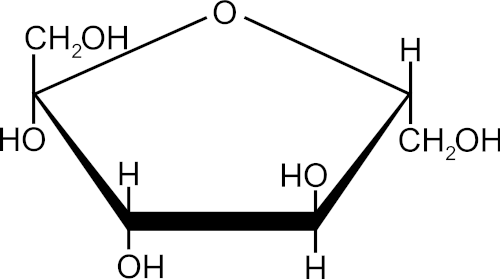
I received an email from a supporter inquiring as to the health value of fructose, a substance that is often listed on the ingredient list of many foods, drinks, energy bars and meal replacement mixes that are marketed as being “healthy”. She wrote, “I recently bought a protein drink mix from a multi-level company to use as a meal replacement and was disappointed to see that fructose was a main ingredient. The person I bought it from told me that fructose is OK because it is natural and comes from fruit. Is this true?”
The information that person gave about fructose is not accurate. It is an example of how people, especially those who are selling “health” products, are not fully aware of how sweeteners are manufactured and how they behave in the body. There is virtually no sweetener that is added to foods that is 100% natural. And just as an aside, most people who are selling health products are not nutrition professionals, and have been fed a standard line of inadequate or inaccurate information to spew whenever someone asks about the ingredients in a product. I have been on the receiving end of many of these uninformed automatons and am always amused by the answers I get to my very probing questions about products I am being solicited to buy or promote. But I digress – here’s the truth about fructose.
Fructose, otherwise known as crystalline fructose, is not natural. While it is true that SMALL amounts of naturally occurring fructose are found in most vegetables and fruits, that type of fructose is not what is being used in so-called “health” drinks.
The small amounts of fructose in fruits and vegetables are balanced by glucose and many other nutrients that help the body process it properly. However, consuming too much fructose at once (like the amounts that are added to foods and drinks) seems to overwhelm the body’s capacity to process it. The diets of our ancestors contained only very small amounts of fructose. These days, estimates are that about 10% of the modern diet comes from fructose.
Dr. Andrew Weil says this about fructose: “The body doesn’t handle large amounts of fructose well. You can maintain life with intravenous glucose, but not with intravenous fructose; severe derangement of liver function results. There’s also evidence that a high intake of fructose elevates levels of circulating fats (serum triglycerides), increasing the risk of heart disease. I never use fructose in my home.”
I never use it in my home either. Or anywhere outside my home. Fructose and glucose are metabolized differently in the body. Glucose is metabolized in every cell of the body, however all fructose must be metabolized in the liver. Too much fructose in the liver turns to fat. A recent study out of Duke University showed that daily consumption of fructose-containing foods or drinks has been associated with Non-Alcoholic Fatty Liver Disease. Nonalcoholic fatty liver disease refers to a wide spectrum of liver diseases ranging from simple fatty liver, to nonalcoholic steato-hepatitis (NASH), to nonalcoholic cirrhosis of the liver.
Fatty liver is a degenerative disease of the liver where the liver cells are literally choked to death by globules of fatty substances within them. It becomes enlarged and swollen with greasy deposits of fatty tissue. The term nonalcoholic is used because this type of liver disease is occurring in people who consume little to no alcohol. Yet, in many respects, the nature of NAFLD is similar to what is seen in liver disease of alcoholics who consume excessive amounts of alcohol.
Most people with NASH feel well and are not aware that they have a liver problem. Nevertheless, NASH can be severe and can lead to cirrhosis, in which the liver is permanently damaged and scarred and no longer able to work properly.
I have long been warning on the dangers of consuming high fructose corn syrup. Now consumption of fructose (crystalline fructose) is showing a similar health disaster. Perhaps it is because of the way that crystalline fructose is produced – not from fruits and vegetables, but from high fructose corn syrup!
High fructose corn syrup contains up to 80 percent fructose and only 20 percent glucose. By allowing high fructose corn syrup to crystallize, most of the glucose is removed. What remains is about 99.5% pure fructose crystals, which are then dried and milled into the desired particle size for packaging. It amounts to refined sugar at its worst.
The biggest reason fructose is so bad is because of the products it is being placed in: protein meal replacement drinks, protein bars, cereals, salad dressings, “natural sodas” energy drinks, and other processed foods that are marketed as being healthy. There is an entire category of beverages, marketed as healthful for you and your body, most commonly encouraged to drink after working out. In reality, you would be better off drinking a Coke after a hard exercise routine, as compared to health drinks with fructose in them. Not that I’m advocating Coke in any way, but pure fructose is worse for you than high fructose corn syrup.
There’s also new sweetener on the market being touted as healthy called Whey Low that is endorsed by a cardiologist and was created by a chef. It is made of crystalline fructose, lactose, and sucrose. It may have a low glycemic index, but the fructose part of the formula is scary. Remember, sweeteners containing large amounts of fructose will be low glycemic because fructose does not get metabolized in the cells, so it doesn’t produce a glycemic response. It all goes to the liver to be stored as fat!
This is just another example of how the food industry and the corn industry have managed to get a toxic substance into the food you eat. And they are good at convincing people that just because it exists in fruits and vegetables, and just because it is low glycemic, that it can be labeled as natural and healthy.
Coincidentally (or perhaps not really), I recently watched the most fabulous show on the University of California channel on the topic of sugar and fructose called Sugar: The Bitter Truth. It is part of a series at UC San Francisco called Mini Medical School for the Public. If you want to know why fructose is so damaging to health, you should definitely watch this. The presenter, Dr. Robert Lustig, M.D., is a professor of Pediatrics at UCSF Medical Center in the Division of Endodrinology. It’s 90 minutes, and I found out that the entire show can be played on YouTube. Please watch – I believe you will find it fascinating!

